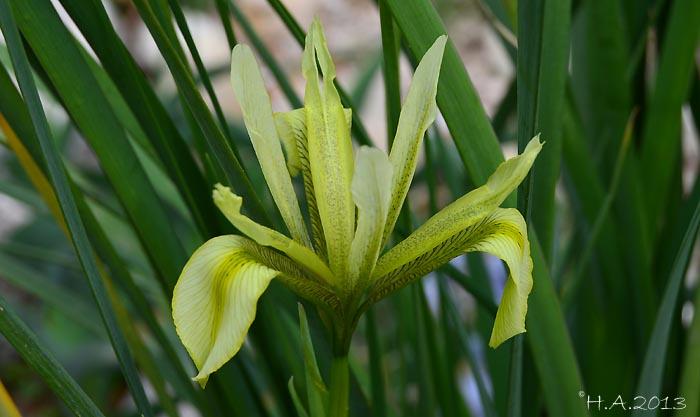Iris grant-duffii














Botanical Name: Iris grant-duffii (added by D. Kramb, 03-DEC-03)
Botanical Synonyms:
Iris melanosticta ? (D. Kramb, 06-SEP-04)
Classification:
Aril (D. Kramb, 03-DEC-03)
Limniris (beardless -- NOT an Aril species) (D. Kramb, 06-SEP-04)
Syriacae (D. Kramb, 20-SEP-04)
Common Names:
N/A
Chromosome Count:
2n=24 (D. Kramb, 20-SEP-04)
General Description:
The flower size is about 8 cm in diameter. (D. Kramb, 03-DEC-03)
Flowers are greenish-yellow. The plants are up to 70 cm high, and grow in tufts from compact rhizomes. The grayish green leaves are up to 70cm long and about 6 per shoot. They are flat, linear, upright, and strongly veined. At the base of each shoot there are very prickly fibers formed from old leaf-sheaths. Each stalk bears a single flower, colored greenish-yellow. The tube is about 7mm long. The falls are 6-7cm long, with purple to lilac veins. The standards are 5cm long, erect, and narrower than the falls. The leaves appear in early winter and reach their full length in about two months. Flowering occurs between February (in the coastal plains) and April (in the Golan). The seeds ripen and scatter during summer. (D. Kramb, 06-SEP-04)
Distinguishing Features:
Iris stands are distinctive in that no other plant species can flourish in the same sites. Seeds of other species which germinate in I. grant-duffii locations do not take hold. (D. Kramb, 06-SEP-04)
Preferred Habitat:
Prefers seasonally wet lands and swamps - which are becoming increasingly rare due to cultivation of the land. (D. Kramb, 03-DEC-03)
All wild populations found in Israel occurred in deep, heavy soils, occasionally inundated in winter, and usually on the edge of seasonal streambeds. The habitat is flat marshy areas on the coastal plain and inland valleys. The species is relatively resistant to dry conditions, and can weather the desiccation of its habitats during the summer. (D. Kramb, 06-SEP-04)
Hardiness:
N/A
Native Range:
Israel (D. Kramb, 03-DEC-03)
Status in the Wild:
Decimated during the 20th century due to the rapid expansion of farming and the resulting pollution of the waterways due to pesticides. But still found in isolated stands throughout the country. Rare and endangered. (D. Kramb, 06-SEP-04)
Correction to above - the epilogue to the SIGNA article further mentions that most of those isolated stands have disappeared due to land development. The species now primarily exists only in the Nov meadow nature reserve. (D. Kramb, 06-SEP-04)
Commercial Availability:
N/A
Sources Cited:
Info entered on 06-SEP-04 comes from the fall 1999 SIGNA bulletin #63, pages 3234-39. (D. Kramb, 06-SEP-04)
Info entered on 20-SEP-04 comes from the SIGNA Checklist of Iris Species (D. Kramb, 20-SEP-04)
Additional Comments:
Collected by the British General Grant-Duff from the banks of Nahal Qishon, in the Esdraelon Valley, and described in 1892 as a new species of the Limniris section. It's Hebrew name ("Irus ha-bitzot" the swamp iris) derives from its habitat of marshy areas. (D. Kramb, 06-SEP-04)
 Species Iris Group of North America
Species Iris Group of North America






